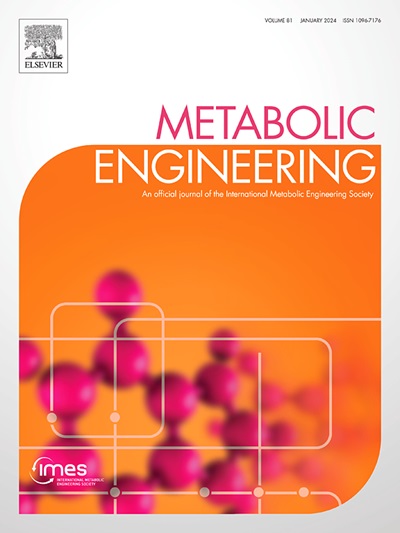Multi-omics driven genome-scale metabolic modeling improves viral vector yield in HEK293
IF 6.8
1区 生物学
Q1 BIOTECHNOLOGY & APPLIED MICROBIOLOGY
引用次数: 0
Abstract
HEK293 cells are a versatile cell line extensively used in the production of recombinant proteins and viral vectors, notably Adeno-associated virus (AAV) (Bulcha et al., 2021). Despite their high transfection efficiency and adaptability to various culture conditions, challenges remain in achieving sufficient yields of active viral particles. This study presents a comprehensive multi-omics analysis of two HEK293 strains under good manufacturing practice conditions, focusing on the metabolic and cellular responses during AAV production. The investigation included lipidomic, exometabolomic, and transcriptomic profiling across different conditions and time points. Genome-scale metabolic models (GSMMs) were reconstructed for these strains to elucidate metabolic shifts and identify potential bottlenecks in AAV production. Notably, the study revealed significant differences between a High-producing (HP) and a Low-producing (LP) HEK293 strains, highlighting pseudohypoxia in the LP strain. Key findings include the identification of hypoxia-inducible factor 1-alpha (HIF-1) as a critical regulator in the LP strain, linking pseudohypoxia to poor AAV productivity. Inhibition of HIF-1 resulted in immediate cessation of cell growth and a 2.5-fold increase in viral capsid production, albeit with a decreased number of viral genomes, impacting the full-to-empty particle ratio. This trade-off is significant because it highlights a key challenge in AAV production: achieving a balance between capsid assembly and genome packaging to optimize the yield of functional viral vectors. Overall this suggests that while HIF-1 inhibition enhances capsid assembly, it simultaneously hampers nucleotide synthesis via the pentose phosphate pathway (PPP), necessary for nucleotide synthesis, and therefore for AAV genome replication.
多组学驱动的基因组尺度代谢模型提高了HEK293病毒载体的产量
HEK293细胞是一种多功能细胞系,广泛用于生产重组蛋白和病毒载体,特别是腺相关病毒(AAV) (Bulcha et al., 2021)。尽管它们具有较高的转染效率和对各种培养条件的适应性,但在获得足够的活性病毒颗粒产量方面仍然存在挑战。本研究在良好生产规范条件下对两株HEK293菌株进行了全面的多组学分析,重点研究了AAV生产过程中的代谢和细胞反应。调查包括不同条件和时间点的脂质组学、外代谢组学和转录组学分析。为阐明这些菌株的代谢变化并确定AAV生产的潜在瓶颈,我们重建了基因组尺度的代谢模型(GSMMs)。值得注意的是,该研究揭示了高产(HP)和低产(LP) HEK293菌株之间的显著差异,突出了LP菌株的假缺氧。主要发现包括鉴定缺氧诱导因子1- α (HIF-1α)是LP菌株的关键调节因子,将假性缺氧与AAV生产力低下联系起来。抑制HIF-1α导致细胞生长立即停止,病毒衣壳产量增加2.5倍,尽管病毒基因组数量减少,影响满空颗粒比。这种权衡是重要的,因为它突出了AAV生产中的一个关键挑战:实现衣壳组装和基因组包装之间的平衡,以优化功能性病毒载体的产量。总的来说,这表明虽然HIF-1α抑制增强了衣壳组装,但它同时阻碍了戊糖磷酸途径(PPP)的核苷酸合成,这是核苷酸合成所必需的,因此也是AAV基因组复制所必需的。
本文章由计算机程序翻译,如有差异,请以英文原文为准。
求助全文
约1分钟内获得全文
求助全文
来源期刊

Metabolic engineering
工程技术-生物工程与应用微生物
CiteScore
15.60
自引率
6.00%
发文量
140
审稿时长
44 days
期刊介绍:
Metabolic Engineering (MBE) is a journal that focuses on publishing original research papers on the directed modulation of metabolic pathways for metabolite overproduction or the enhancement of cellular properties. It welcomes papers that describe the engineering of native pathways and the synthesis of heterologous pathways to convert microorganisms into microbial cell factories. The journal covers experimental, computational, and modeling approaches for understanding metabolic pathways and manipulating them through genetic, media, or environmental means. Effective exploration of metabolic pathways necessitates the use of molecular biology and biochemistry methods, as well as engineering techniques for modeling and data analysis. MBE serves as a platform for interdisciplinary research in fields such as biochemistry, molecular biology, applied microbiology, cellular physiology, cellular nutrition in health and disease, and biochemical engineering. The journal publishes various types of papers, including original research papers and review papers. It is indexed and abstracted in databases such as Scopus, Embase, EMBiology, Current Contents - Life Sciences and Clinical Medicine, Science Citation Index, PubMed/Medline, CAS and Biotechnology Citation Index.
 求助内容:
求助内容: 应助结果提醒方式:
应助结果提醒方式:


